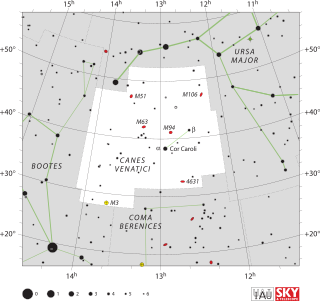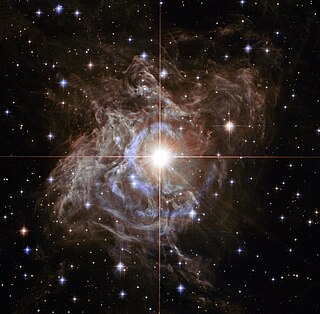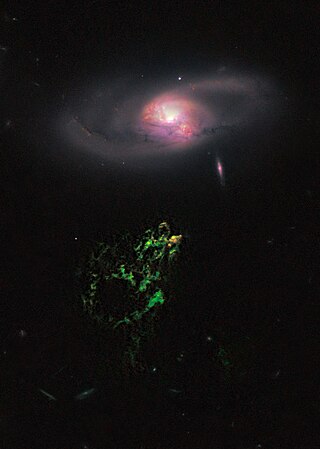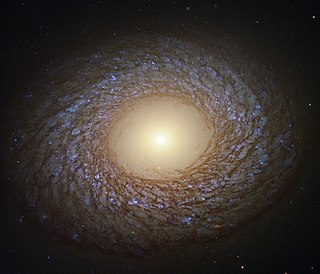A void galaxy is a galaxy located in a cosmological void. [1] Few galaxies exist in voids; most are located in sheets, walls and filaments that surround voids and supervoids. [2] [3] Many void galaxies are connected through void filaments [4] or tendrils, [5] less massive versions of the regular galaxy filaments that surround voids. These filaments are often straighter than their non-void counterparts due to the lack of influence by surrounding filaments. [4] These filaments can even be rich enough to form poor galaxy clusters. [6] The void galaxies themselves are thought to represent pristine examples of galactic evolution, having few neighbours, and likely to have formed from pure intergalactic gas. [7]
It is theorised by many astrophysicists that void galaxies are the result of large galactic filaments being pulled by the gravity of a major super cluster out of the less densely populated areas, causing voids such as the Boötes Void to grow. Galaxies such as MCG+01-02-015 are sometimes left behind from such events. [8]

Canes Venatici is one of the 88 constellations designated by the International Astronomical Union (IAU). It is a small northern constellation that was created by Johannes Hevelius in the 17th century. Its name is Latin for 'hunting dogs', and the constellation is often depicted in illustrations as representing the dogs of Boötes the Herdsman, a neighboring constellation.

A galaxy is a system of stars, stellar remnants, interstellar gas, dust, and dark matter bound together by gravity. The word is derived from the Greek galaxias (γαλαξίας), literally 'milky', a reference to the Milky Way galaxy that contains the Solar System. Galaxies, averaging an estimated 100 million stars, range in size from dwarfs with less than a hundred million stars, to the largest galaxies known – supergiants with one hundred trillion stars, each orbiting its galaxy's center of mass. Most of the mass in a typical galaxy is in the form of dark matter, with only a few percent of that mass visible in the form of stars and nebulae. Supermassive black holes are a common feature at the centres of galaxies.
The following is a timeline of galaxies, clusters of galaxies, and large-scale structure of the universe.

A Cepheid variable is a type of variable star that pulsates radially, varying in both diameter and temperature. It changes in brightness, with a well-defined stable period and amplitude.

Messier 87 is a supergiant elliptical galaxy in the constellation Virgo that contains several trillion stars. One of the largest and most massive galaxies in the local universe, it has a large population of globular clusters—about 15,000 compared with the 150–200 orbiting the Milky Way—and a jet of energetic plasma that originates at the core and extends at least 1,500 parsecs, traveling at a relativistic speed. It is one of the brightest radio sources in the sky and a popular target for both amateur and professional astronomers.

The Hubble Deep Field (HDF) is an image of a small region in the constellation Ursa Major, constructed from a series of observations by the Hubble Space Telescope. It covers an area about 2.6 arcminutes on a side, about one 24-millionth of the whole sky, which is equivalent in angular size to a tennis ball at a distance of 100 metres. The image was assembled from 342 separate exposures taken with the Space Telescope's Wide Field and Planetary Camera 2 over ten consecutive days between December 18 and 28, 1995.

A dwarf galaxy is a small galaxy composed of about 1000 up to several billion stars, as compared to the Milky Way's 200–400 billion stars. The Large Magellanic Cloud, which closely orbits the Milky Way and contains over 30 billion stars, is sometimes classified as a dwarf galaxy; others consider it a full-fledged galaxy. Dwarf galaxies' formation and activity are thought to be heavily influenced by interactions with larger galaxies. Astronomers identify numerous types of dwarf galaxies, based on their shape and composition.
Amy J. Barger is an American astronomer and Henrietta Leavitt Professor of Astronomy at the University of Wisconsin–Madison. She is considered a pioneer in combining data from multiple telescopes to monitor multiple wavelengths and in discovering distant galaxies and supermassive black holes, which are outside of the visible spectrum. Barger is an active member of the International Astronomical Union.

Knowledge of the location of Earth has been shaped by 400 years of telescopic observations, and has expanded radically since the start of the 20th century. Initially, Earth was believed to be the center of the Universe, which consisted only of those planets visible with the naked eye and an outlying sphere of fixed stars. After the acceptance of the heliocentric model in the 17th century, observations by William Herschel and others showed that the Sun lay within a vast, disc-shaped galaxy of stars. By the 20th century, observations of spiral nebulae revealed that the Milky Way galaxy was one of billions in an expanding universe, grouped into clusters and superclusters. By the end of the 20th century, the overall structure of the visible universe was becoming clearer, with superclusters forming into a vast web of filaments and voids. Superclusters, filaments and voids are the largest coherent structures in the Universe that we can observe. At still larger scales the Universe becomes homogeneous, meaning that all its parts have on average the same density, composition and structure.

In cosmology, galaxy filaments are the largest known structures in the universe, consisting of 'walls' of gravitationally bound galactic superclusters. These massive, thread-like formations can reach 80 megaparsecs h−1 and form the boundaries between voids. Galaxy filaments form the cosmic web and define the overall structure of the observable universe.

Hanny's Voorwerp, is a rare type of astronomical object called a quasar ionization echo. It was discovered in 2007 by Dutch schoolteacher Hanny van Arkel while she was participating as a volunteer in the Galaxy Zoo project, part of the Zooniverse group of citizen science websites. Photographically, it appears as a bright blob close to spiral galaxy IC 2497 in the constellation Leo Minor.

NGC 2775, also known as Caldwell 48, is a spiral galaxy in the constellation Cancer. It is 67 million light-years away from the Milky Way. It was discovered by William Herschel in 1783. NGC 2775 belongs to the Antlia-Hydra Cluster of galaxies and is the most prominent member of the NGC 2775 Group, a small galaxy group in the Virgo Supercluster, along with the Local Group. Other members of the NGC 2775 Group include NGC 2777 and UGC 4781.

UDFj-39546284 is a high-redshift Lyman-break galaxy discovered by the Hubble Space Telescope in infrared Hubble Ultra-Deep Field (HUDF) observations in 2009. The object, located in the Fornax constellation, was identified by G. Illingworth, R. Bouwens and the HUDF09 Team during 2009 and 2010. It was reported with a redshift of z~10 using Hubble and Spitzer Space Telescope photometric data, with later reports in 2012 suggesting a possibly higher redshift of z = 11.9 Although doubts were raised that this galaxy could instead be a low-redshift interloper with extreme spectral emission lines producing the appearance of a very high redshift source, later spectroscopic observations by the James Webb Space Telescope's NIRSpec instrument in 2022 confirmed the galaxy's high redshift to a spectroscopically confirmed estimate of z = 11.58.

NGC 7090 is a spiral galaxy in the southern constellation of Indus located about 31 million light-years away. English astronomer John Herschel first observed this galaxy on 4 October 1834.

Cosmic voids are vast spaces between filaments, which contain very few or no galaxies. The cosmological evolution of the void regions differs drastically from the evolution of the Universe as a whole: there is a long stage when the curvature term dominates, which prevents the formation of galaxy clusters and massive galaxies. Hence, although even the emptiest regions of voids contain more than ~15% of the average matter density of the Universe, the voids look almost empty to an observer. Voids typically have a diameter of 10 to 100 megaparsecs ; particularly large voids, defined by the absence of rich superclusters, are sometimes called supervoids. They were first discovered in 1978 in a pioneering study by Stephen Gregory and Laird A. Thompson at the Kitt Peak National Observatory.
The KBC Void is an immense, comparatively empty region of space, named after astronomers Ryan Keenan, Amy Barger, and Lennox Cowie, who studied it in 2013. The existence of a local underdensity has been the subject of many pieces of literature and research articles.

NGC 5965 is a spiral galaxy located in the constellation Draco. It is located at a distance of circa 150 million light years from Earth, which, given its apparent dimensions, means that NGC 5965 is about 260,000 light years across. It was discovered by William Herschel on May 5, 1788.

MCG+01-02-015 is a spiral galaxy in the constellation Pisces. It is an example of a void galaxy, and noted to be one of the loneliest galaxies spotted, with no other galaxy around 100 million light-years in all directions.